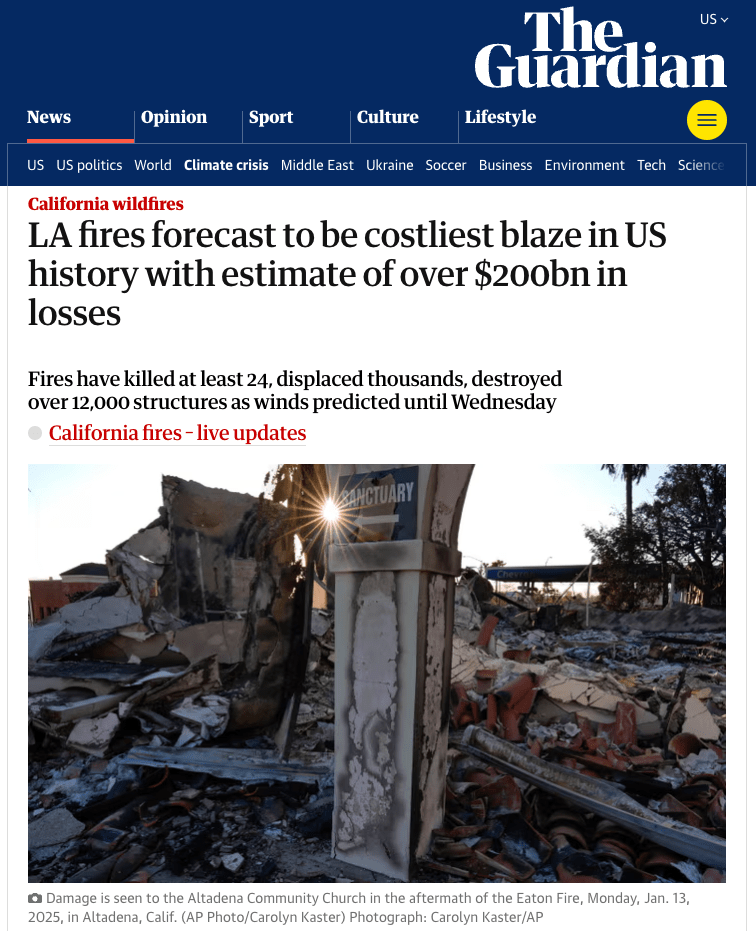
How much do you think we should spend now to cut the risk of a $200 billion catastrophe in half, from 2% per year to 1% per year, for the next 100 years?
pollev.com/chrismakler


How much do you think we should spend now to cut the risk of a $200 billion catastrophe in half, from 2% per year to 1% per year, for the next 100 years?
This will depend on two factors:
How much do you value the future vs. the present?
How do you feel about
risk and uncertainty?
Time and Risk:
Applications and Extensions
Christopher Makler
Stanford University Department of Economics
Econ 50: Lecture 13
Risk Aversion
and Insurance
Expected Value
If a random variable \(X\) takes on values \(x_1,x_2,x_3,...,x_n\) with probabilities \(\pi_1,\pi_2,\pi_3,...,\pi_n\), where the \(\pi\)'s all add up to 1, then the expected value of \(X\) is
Example:
Suppose there is a 50% chance it will rain tomorrow,
If it rains, there is an 80% chance it will rain 10mm,
and a 20% chance it will rain 20mm.
What is the expected value of the amount of rain?
pollev.com/chrismakler

Two ways of framing the same question:
You face a lottery:
\(c_1 = \$16\) with probability \(\pi = {1 \over 4}\)
\(c_2 = \$64\) with probability \((1-\pi) = {3 \over 4}\)
You have $64, and you face a 25% risk of losing $48
What is the expected value of this lottery?
What is your expected loss?
What is the expected value of your consumption?
pollev.com/chrismakler

You have $64 and face a 25% chance of losing $48.
We just showed that your expected consumption is $52.
Is this an amount you ever actually consume?
Two ways of framing the same question:
You face a lottery:
You have $64, and you face a 25% risk of losing $48
Now suppose your value function for money is \(v(c) = \sqrt{c}\).
What is your expected utility?
\(c_1 = \$16\) with probability \(\pi = {1 \over 4}\)
\(c_2 = \$64\) with probability \((1-\pi) = {3 \over 4}\)
utils
Two ways of framing the same question:
You face a lottery:
You have $64, and you face a 25% risk of losing $48
\(c_1 = \$16\) with probability \(\pi = {1 \over 4}\)
\(c_2 = \$64\) with probability \((1-\pi) = {3 \over 4}\)
What is your certainty equivalent for this lottery?
pollev.com/chrismakler

Two ways of framing the same question:
You have $64, and you face a 25% risk of losing $48
You face a lottery:
\(c_1 = \$16\) with probability \(\pi = {1 \over 4}\)
\(c_2 = \$64\) with probability \((1-\pi) = {3 \over 4}\)
Buying Insurance against a Loss
Money in good state
Money in bad state
100
20
Suppose you have $100. Life's good.
If your phone breaks, you have to pay $80 to repair the screen, leaving you with $20.
You might want to insure against this loss by buying a contingent contract that pays you $K in the case your phone breaks.
Money in good state
Money in bad state
100
20
You want to insure against this loss by buying a contingent contract that pays you $K in the case you break your screen. Suppose this costs $P.
Now in the good state, you have $100 - P.
In the bad state, you have $20 - P + K.
100 - P
20 + K - P
Budget line
Note: along the "line of certainty" where \(c_1 = c_2\),
it must be the case that \(v'(c_1) = v'(c_2)\),
so the MRS is just \(\frac{\pi}{1-\pi}\)
How much can you consume in the future if you save all your present income \(m_1\)?
How much can you consume in the present if you borrow the maximum amount against your future income?
Supply of Savings and
Demand for Borrowing
Gross demand = your optimal bundle given interest rate \(r = (c_1^*(r), c_2^*(r))\)
If you want to consume more than your present income at interest rate \(r\),
your demand for borrowing is
\(b(r) = c_1^*(r) - m_1\)
How does this compare to your initial income stream \((m_1,m_2)\)?
If you want to consume less than your present income at interest rate \(r\),
your supply of savings is
\(s(r) = m_1 - c_1^*(r)\)
Inflation and Real Interest Rates
Suppose there is inflation,
so that each dollar saved can only buy
\(1/(1 + \pi)\) of what it originally could:
Up to now, we've been just looking at
dollar amounts in both periods
We call \(r\) the "nominal interest rate" and \(\rho\) the "real interest rate"
For low values of \(r\) and \(\pi\), \(\rho \approx r - \pi\)
"Present Value" for two periods
Beyond Two Periods
If you save \(s\) now, you get \(x = s(1 + r)\) next period.
The amount you have to save in order to get \(x\) one period in the future is
Remember how we got this...
If you save \(s\) now, you get \(x = s(1 + r)\) next period.
The amount you have to save in order to get \(x\) one period in the future is
If you save for two periods, it grows at interest rate \(r\) again, so \(x_2 = (1+r)(1+r)s = (1+r)^2s\)
Therefore, the amount you have to save in order to get \(x_2\) two periods in the future is
If you save for two periods, it grows at interest rate \(r\) again, so \(x_2 = (1+r)(1+r)s = (1+r)^2s\)
Therefore, the amount you have to save in order to get \(x_2\) two periods in the future is
If you save for \(t\) periods, it grows at interest rate \(r\) each period, so \(x_t = (1+r)^ts\)
Therefore, the amount you have to save in order to get \(x_t\), \(t\) periods in the future, is
Therefore, the amount you have to save in order to get \(x_t\), \(t\) periods in the future, is
We call this the present value of a payoff of \(x_t\)
Application: Social Cost of Carbon

Obama Admin: $45
Uses a 3% discount rate; includes global costs
Trump Admin: less than $6
Uses a 7% discount rate; only includes American costs
PV of $1 Trillion in 2100:
$86B for Obama, $4B for Trump
Risky Assets and Optimal Portfolio Theory
Econ 50 | Fall 25 | Lecture 13
By Chris Makler
Econ 50 | Fall 25 | Lecture 13
We apply the framework of consumer choice theory to the choice of how to allocation money across time, investigating saving and borrowing.
- 270



